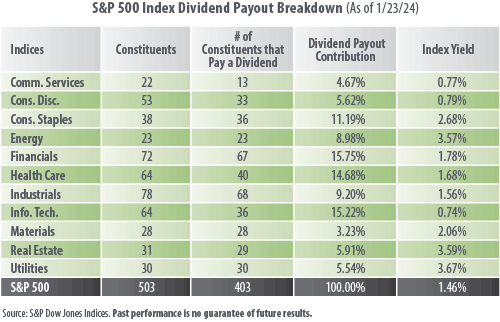by Bob Carey, Chief Market Strategist, First Trust Portfolios
 View from the Observation Deck
View from the Observation Deck
Companies often return capital to their shareholders through dividend distributions. The practice is so common that as of 1/23/24, 403 of the 503 constituents in the S&P 500 Index (“the Index”) distributed a cash dividend to their equity owners. In addition to acting as a conduit for return of capital, dividend distributions account for a significant portion of the Index’s total return. According to data from Bloomberg, dividends contributed to over 37% of the total return of the Index over the 96-year period between December 30, 1927, and December 29, 2023.
- Data from Bloomberg indicates that the dividend payments from S&P500 Index constituents totaled $70.91 per share (record high) in 2023, up from $67.57 (previous record high) in 2022. As of 1/31/24, dividend payments are estimated to total $74.54 and $79.66 per share in 2024 and 2025, respectively.
- Of the 11 major sectors that comprise the S&P 500 Index, eight of them had yields above the 1.46% generated by the Index over the period captured in the table. Financials, Information Technology, and Health Care contributed the most to the Index's dividend payout at 15.75%, 15.22% and 14.68%, respectively.
- The payout ratio for the S&P 500 Index stood at 36.89% on 12/29/23. A dividend payout ratio between 30% and 60% is typically a good sign that a dividend distribution is sustainable, according to Nasdaq.
- Many investors view changes in dividend distributions as an indication of strength and or weakness in the underlying company. For that reason, companies will often avoid decreasing or suspending their dividend payout. There were a total of 25 dividend cuts and four suspensions in the Index in 2023. For comparative purposes, not a single dividend was suspended in 2022, and only five dividend reductions were recorded over the period.
Takeaway: Dividend distributions continue to be one of the most efficient methods by which companies can return capital to their shareholders. In 2023, the companies that comprise the S&P 500 Index distributed a record $70.91 per share to their equity owners and are forecast to return even higher amounts over the next several years. Additionally, dividend distributions have contributed meaningfully to the performance of the S&P 500 Index, over time. In the 96-year period between December 30, 1927, and December 29, 2023, more than 37% of the total return of the Index came from dividend distributions, according to data from Bloomberg. That said, investors may want to keep a close eye on dividend sustainability. There were a total of 25 dividend cuts in 2023, the fourth-highest total for dividend reductions over the past 20 years. For comparison, the Index suffered 68, 40, and 27 dividend cuts, respectively, in 2008, 2007, and 2020.
This chart is for illustrative purposes only and not indicative of any actual investment. The illustration excludes the effects of taxes and brokerage commissions and other expenses incurred when investing. Investors cannot invest directly in an index. The S&P 500 Index is a capitalization-weighted index comprised of 500 companies used to measure large-cap U.S. stock market performance, while the 11 major S&P 500 Sector Indices are capitalization-weighted and comprised of S&P 500 constituents representing a specific sector.
Download a PDF of this post, please click here.
Copyright © First Trust Portfolios














